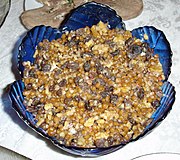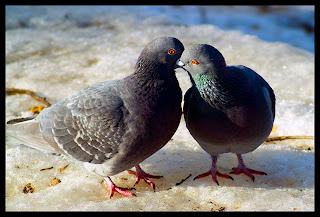Hello Everyone and Greetings from ROMANIA
 Finally I've found some time to continue this Forum and to put up another thread in the propper time! I hope you will enjoy, as you did before, these trips into our traditions and culture with me as your guide :-) and story teller! I know I'm not the best but at least there are so many new and interesting things to find out. So Finally I've found some time to continue this Forum and to put up another thread in the propper time! I hope you will enjoy, as you did before, these trips into our traditions and culture with me as your guide :-) and story teller! I know I'm not the best but at least there are so many new and interesting things to find out. So
WELCOME TO FEBRUARY :-)
The old name of February: "Faur" or "Faurar" (the old Romanian word for
"ironsmith"), involves not only the ironsmith who prepares this month
the objects used in the spring tilling, but also the frost which gives
birth to new shapes.
The celebrations of this month are:
- February 1st: Trif, The Madman
- February 2nd: The Welcome of The Lord (also named "Stefania"); The Winter Martins
- February 10th: St. Haralambie
- February 11th: St Vasile
- February 24th: Dragobet
February 1: Trif, the Madman
The first day of February is dedicated to St. Trif and represents the
first great celebration of the grape-growing, fruit-growing and
agricultural calendar. For this reason, St. Trif's day is mostly
celebrated in the hill and mountain areas.
The Moldavian legend goes that Trif was a man who liked to sing and
party. One day, as he was tilling his land, Virgin Mary passed by,
taking little Jesus to church for the first time. Taking her for
another woman, Trif insidiously coughed after her. Angry, Virgin Mary
stopped and told him: <<Mad man, let today be your day and tomorrow
mine!�. Then she turned away.>>
Ever since Trif is called Madman Trif, and his celebration is one day before Virgin Mary's Day.
Another version of the story tells that Virgin Mary met Trif on her
road to the church and they walked together. Suddenly, Trif wanted to
get ahead and stepped on her dress. Angry, Virgin Mary said to him: <<Get ahead, madman, get ahead!�. For shame, Trif got ahead and never
looked back.>>
A legend from Bucovina goes that a bunch of people lead by Trif, an
important Jerusalem leader wanted to kill Jesus when He was brought by
his mother to the temple. The angel protected little Jesus and gave
Trif the mind of a madman. Seeing this, the others got scared and gave
up their evil plan. After Trif came round, he became a saint.
According to another type of legend, Trif was a Christian persecuted by
pagans. Trying to escape, he pretended to be a madman, but he was
guarded even better. One night, God opened his cell and let him go out.
Ever since, people think that Trif is a saint and that if they don`t
celebrate his day, they would go mad.
During this day one shouldn't work for fear that the vineyard would be
affected by hail and the wolves would eat the cattle. People also
celebrate Trif's day in order not to go mad, not to go poor or they
simply remember his sufferance.
***Of course all of this, nowerday is JUST legend, and we all have to work and almost no one get mad LOL***
Another legend has it that Trif protected Virgin Mary and her son of
St. Peter's dogs, while St. Peter was taking care of his cattle and
didn't pay attention. As a reward, Virgin Mary made St. Trif the master
of the caterpillars, cockroaches and insects in generally. Women paste
all the holes in the house, including the oven or the hearth, thinking
that the eyes and the mouth of the birds, worms and harmful insects
would be this way shut.
A bowl with corn flour is doled, in order that the grasshoppers should not eat the harvest of the next summer.
 St. Trif is also seen as the patron of the wolves. It is said that once
upon a time a man went to hunt. He climbed a tree and began to shot
wolves. After his bullets had finished, he saw a man dressed in white
clothes. He was telling to the wolves what each one should eat. A gimp
wolf was the last to come and St. Trif (he was the man in white) told
him to eat the man from the tree. Scared, the man cried for help. Some
people working in the wood came and hunted away the wolf. The man
arrived at home and told his boys to make a wooden box and carry him in
it. They followed his order. Once, while walking to a fair, he met a
man. He was running and asked them to hide him, as a wolf was following
him. The boys put him in the box, together with their father. They
waited, but the wolf didn't show up. Then they opened the box. A wolf came
out and ran away. It had eaten their father, as he had been meant to it
by St. Trif. St. Trif is also seen as the patron of the wolves. It is said that once
upon a time a man went to hunt. He climbed a tree and began to shot
wolves. After his bullets had finished, he saw a man dressed in white
clothes. He was telling to the wolves what each one should eat. A gimp
wolf was the last to come and St. Trif (he was the man in white) told
him to eat the man from the tree. Scared, the man cried for help. Some
people working in the wood came and hunted away the wolf. The man
arrived at home and told his boys to make a wooden box and carry him in
it. They followed his order. Once, while walking to a fair, he met a
man. He was running and asked them to hide him, as a wolf was following
him. The boys put him in the box, together with their father. They
waited, but the wolf didn't show up. Then they opened the box. A wolf came
out and ran away. It had eaten their father, as he had been meant to it
by St. Trif.
People from Bucovina say that the weather will be beautiful if there is
snow on February 1st. On the other hand, if there is no snow, it will
soon snow.
An old custom of this day is called "Gurbanu Viilor" (in Romanian
language, "viilor" = of the vineyards). Men gather and go to the
vineyards. Before leaving the village, they shout: <<Let's go to
Gurbanu!>>. On the hills, they cut grape guts and make chaplets and
belts for themselves. Then they dig out the wine bottle they had buried
last autumn and the party begins. Gathered around a fire, on a hill,
they eat, drink, dance, jump over the fire and throw wine one on each
other. In the evening, they return home carrying torches and they
continue the party with their families.
***what a pitty for the vine throuwn away?! LOL***
February 2nd: The Welcome of the Lord (also named "Stretenia");
The Winter "Martins" (February 1-3)
This is the day when Jesus was brought to the temple of Jerusalem, 40
days after His birth. February 2nd is also called "Stretenie", with a
Slavic word. As they didn't understand this word, the peasants named
this way a bad dangerous woman, with a contradictory temperament, who
is responsible for the weather changes.
It is believed that now "winter meets summer". In other words, if the
weather is beautiful, so it will be the next summer. But if the weather
is bad, next summer will be cold and poor in crops.
***At that time they knew nothing of greenhouse effect?!***
"The Winter Martins", three at number, are celebrated on February 1-3.
February 2nd is dedicated to the Great Martin. They are the ones who
stop the wolves from eating the cattle. For the same reason, the
garbage should not be taken away. It is also said that one shouldn't
throw coals in the yard, as the wolves come searching for them (it is
believed that the wolves eat coals in order to give birth to more
babies). In Banat region, various rituals are (***were as the mater of fact***) performed on February
1st, in order to protect the sheeps.
It is said that the bear comes out of his den this day. If there's no
sun and the bear can't see its shadow, it goes back and remains in the
den for another six weeks. If the bear sees its shadow, it remains
outside, thinking that the winter has passed. day. If there's no
sun and the bear can't see its shadow, it goes back and remains in the
den for another six weeks. If the bear sees its shadow, it remains
outside, thinking that the winter has passed.
 Holy water mixed with butter is put on the trees, in order to keep the caterpillars away. Holy water mixed with butter is put on the trees, in order to keep the caterpillars away.
The full moon on this night indicates a rich year.
February 10th: St. Haralambie
(Aralampie / Aralambie, Haralam / Aralam)
St. Haralambie is the one who commands the death, the pest and the
cholera. His feast is celebrated for fear of these diseases.The icons
picture St. Haralambie holding the enchained pest.
Some legends say that St. Haralambie was a shepherd, that's why he protects the sheeps and cattles.
According to other legends, when he was very old, the saint traveled
the world and cured the ill people. Once he arrived in the pagan land
and the pagan emperor asked him where his power comes from. The saint
said that his power had been given to him by God. The emperor called
him a wizard and commanded him to renounce his religion and to become a
pagan. St. Haralambie refused. Then the emperor threw him in jail and
commanded the soldiers to flay him. The emperor's daughter asked if he
didn't feel mercy for the man who he was torturing more than Jesus. The
emperor got angry and banished her. His daughter left for the mountains
and became a saint woman. Then ten thousands soldiers were ordered to
take St. Haralambie out of jail and to cut him in little pieces. During
the night, the emperor sent one hundred men to see what had happened. A
great light was around the mass of human flash and the angels were
taking the pieces and pasting them. Thus they made St. Haralambie human
again and they took him to God. The Lord asked him what he wanted for
his sufferance. The Saint asked God to keep the illnesses away from the
people who celebrate his day.
A legend from Bucovina goes that St. Haralambie suffered a lot during
his life. Before his death, God asked him to choose a reward. The Saint
asked the people what he should take. The people told him to take the
pest, which was killing many people in that time. The Lord gave him the
pest and St. Haralambie tied it with a golden chain. Ever since he has
kept it this way. But when people forget about his day, he lets the
pest on the earth and the pest, which has wings and holds a great
sword, goes and kills that people.
Another version of the story has it that St. Haralambie was the last to
come when God assigned jobs to the saints. Thus he received a bitch in
a golden chain.
It is believed that if it rains this day, then the rain will continue for 40 days.
 In some Romanian regions, the women bake a little round bread and tear
it in four parts, which they throw towards the four cardinal points. In
other places, women get naked and go three times around their house:
in the morning, in the afternoon and in the evening. This way, they
believe that the evil is kept away.
In some Romanian regions, the women bake a little round bread and tear
it in four parts, which they throw towards the four cardinal points. In
other places, women get naked and go three times around their house:
in the morning, in the afternoon and in the evening. This way, they
believe that the evil is kept away.
(I've never seen one around any house these days LOL?!)
 On this day food is doled, in the memory of the ones who died a violent
death. The "coliva" (a traditional dish made of boiled grain) is kept
to be given to the poultry in times of pestilence. As this day is a
celebration, people don't work, but who really want to do it is allowed
to tease wool. On this day food is doled, in the memory of the ones who died a violent
death. The "coliva" (a traditional dish made of boiled grain) is kept
to be given to the poultry in times of pestilence. As this day is a
celebration, people don't work, but who really want to do it is allowed
to tease wool.
***nower day we are all egarly willing to work and we all fake to tease wool! LOL***
February 11th: St. Vlasie
It is said that the beaks of the birds open on February 11. That's why
who works on the field will share his crop with the birds, which will
eat what he had seeded. For this reason, mainly the agriculturalists
are the ones to celebrate this day.
The peasants respect this feast in order that the pregnant women should
give birth to healthy children, with no malformations. The same thing
applies to the cattle. When a domestic animal gives birth to babies
with an abnormal number of feet, heads etc., it is said that the devil
has came upon the household.
According to a Moldavian belief, who respects this day will always have money.
It is also believed that one should pray to St. Vlasie if he wants back something he had lost.
February 24: the "Dragobete"
- Valentine's Day, in Romanian stil and tradition -
The "Dragobete" is the day when the spring is said to begin. This day
is dedicated to love and fertility and is also named "the beginning of spring".
Unfortunately its origin isn't known yet. Sometimes, Dragobete appears as the son of the Old Dochia
(or as a shepherd who accompanies her in the mountains) or as the
brother-in-law of Lazarica, another Romanian mythological character.
Dragobete is similar to St. Valentine and he was often compared with
Eros or Cupid.
People say that the one who don't celebrate this day will not be loved
during the year, but the one who does it will be in love every day of
the current year.
The "Dragobete" is the day when couples form. This applies not only to people, but to birds also.

The girls and young women use the snow which didn't melt until this day
for washing them in certain days of the year. The tradition has it that
men shouldn't annoy the women because they will have troubles.
***I think you can easily see this why?!***
The young people dance on the field and, if the weather is sunny, they cull snowdrops.
Birds mate and gather materials for their nest. If a bird didn't mate
on this day, it will not be able to do it anymore and it will fly
chirping from place to place until it dies. Other version says that the
bird won't have babies until the next "Dragobete".
Everything began on this day will turn out just fine. The carpets and
other textiles are shaken out, for the wealth to come back. Only
working inside the house is allowed, for fear of illness.

I very much hope you enjoyed this pritty long trip! If you did I'm waiting you next time or if you want you may pay a visit to my other "old" posts! I'll do my best to come up with some news to each of them!
THANK YOU FOR JOYNING ME!
See you next time = LA REVEDERE :-)
With friendship,
Anamaria
PS: *** mark my own comments and they do not show any tradition :-)
|